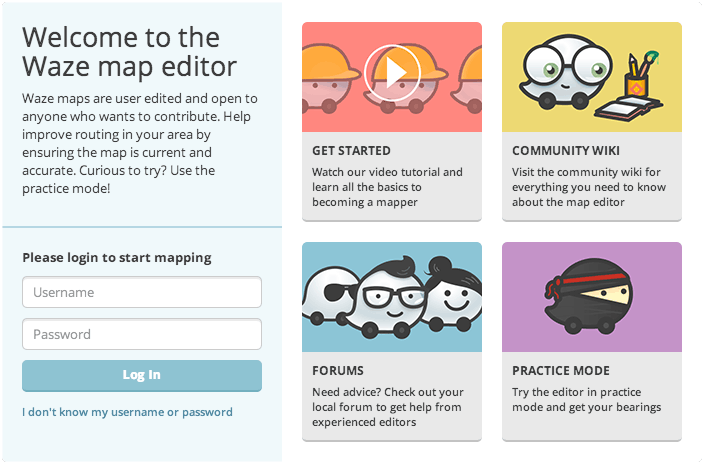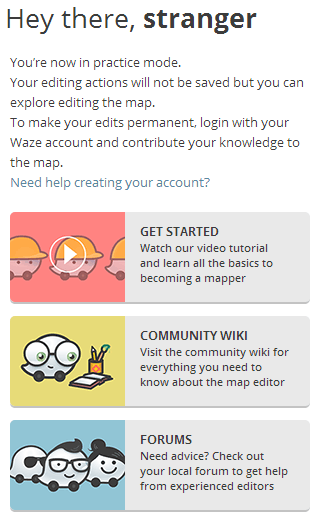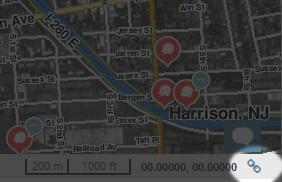الگو:SelectionBar This page is the key starting point for any editor of the Waze maps. Ensure that you read through the entire page to best prepare you for the many bits of information needed to make you a good map editor. People who edit the map without fully understanding many of these elements can do more harm than good with their edits. If you cannot find an answer to your question somewhere in the Wiki, be sure to post a question in the Waze Forums where many experienced Wazers will be happy to provide an answer. Just be sure you did your best to search for the answer in the Wiki here.
The Road Maps History
The Waze map was started in many countries by importing publicly available road data. This data was fairly accurate in geometry, but could be out of date. It also did not include some details vital for a navigation system such as permitted travel direction, and distinctions between drivable roads and non-drivable ways, such as railroads and canals. The imported maps also did not indicate if a junction or bridge was present where roads crossed. Waze defaulted to a junction in all cases, and even though turn restrictions may show as being in place at these junctions, all turns are actually allowed if the segments have never been edited. This set of data was enough to get started, but definitely needed updating and maintenance.
This is where two key aspects of the Waze system come into play:
- The web-based map editing tools for Waze users to edit maps of their neighborhoods, cities or other places with which they are familiar.
- The collecting of GPS data from Waze users to modify the maps to set road direction and turning permissions at intersections.
Some countries had no data available for their road systems, so the maps for these countries must be built from the ground up by Waze users. The maps are created in the web editor using roads recorded in the Waze client and the stored GPS tracks of all Waze users superimposed over available aerial photography.
The Map Editor
Waze is currently using its second generation map editing interface (covered in this article). Known as the Waze Map Editor (or WME for short), it is the default editor for Waze since September 19, 2011. This editor interface was functionally upgraded on May 27, 2014, adding Places functionality to the ROW infrastructure, and the ability to hide closed update requests and map problems. There are currently three different server farms managing the maps of the world. Be sure to select the appropriate server when making edits to a particular part of the world. You can use the same username on all servers, but your editing points are managed separately by each server. Also the maps are not synchronized between the servers, so for example if you went to the North America server to modify parts of Europe, the different server supporting Wazers in Europe would not see your changes.
Map Editing Quick-start Guide
Learning the best map editing techniques for proper navigation and appearance takes some time and practice, but it can be a fun and rewarding experience too. You can be proud that you are improving the experience for all Waze users. The details in later sections of this page are important for you to learn, but for simple edits, there is a Map Editing Quick-start Guide to get you going quickly.
It is very important that all editors take time to read all the documentation found in the editing manual to ensure the Waze map remains complete, accurate, and able to fully and properly route users.
Accessing the Waze Map Editor (WME)
Basics
The Waze Map Editor editor is currently officially supported on the Chrome browser only. It may or may not work on other browsers, but there is currently no official support for issues that might arise.
You can access the map editing page directly using a single URL: http://www.waze.com/editor. Use the menu at the top-right corner of the screen to select between US & Canada, Israel, and World server infrastructures.
If you are at the Waze homepage:
- From the Waze homepage select the Login link at the top-right corner of the screen.
- Click on "Live Map" in the main navigation header.
- Click on "EDIT THE MAP"
When have you successfully arrived at the Waze Map Editor, you are presented with a large splash screen full of information, possible actions, and a place to enter your Waze username and password.

Once logged in, your screen should look something like this:
Best Map Editing Practices
When editing the Waze maps, please be sure to first review this page and also follow the Best map editing practice. You should also be aware of known Waze Map Editor issues or missing features.
Additional Details
Using the WME, you can add, edit, or delete nearly any object within your editable area. If a road segment is locked by a user with a higher editing rank than you, the road, intersection, or turn permissions connected to that road segment cannot be altered unless you chose one of the following:
- Place a request to the Update/Unlock Request forums to unlock that segment by giving them a permalink with the segment or segments highlighted and a country manager may unlock it for you.
- Send a Private Message (PM) to the previous editor using the Forum PM functionality. As of the August 12, 2012 update, Area Managers are no longer able to override segments locked by higher-rank editors.
Be sure to check out the Map Editing Tips and Hints page for some shortcuts for logging in to the map editor and other great pieces of information to enhance your map editing.
Practice Mode

The Waze Map Editor has a Practice mode in which you can perform nearly every action available when logged into the Editor, except that you cannot save any changes. In order to save changes, you must log in. Practice mode is helpful to and should be used by users who are new to map editing in Waze. The editor, while in Practice mode, has icons/buttons and links on the left sidebar area shown here to the left.
There is a significant amount of information organized in the wiki. In fact, nearly every question about Waze has already been asked already, and nearly every answer is in the wiki. That's why it's been created: to answer your questions.
If you are a new editor, take time to read the editing manual and use the editor in Practice mode, practicing the functions you would if you were logged in, but without the worry of permanently messing something up.
Here's some things to test out in Practice Mode:
- Add, delete, update segments.
- Rename a segment, change its direction, road type.
- Connect segments to other segments
- Try changing turn restrictions. Restrict all turns on a junction. See how changing a segment direction affects turn arrows.
- Build a roundabout
- Add a park landmark
- Build an overpass
- Delete extra junctions
- Add an alternate name to a segment
When you are ready to log in and try it for real, use the Log in link found on the bottom Practice Mode bar:

Editable Area
In play mode (not logged in), all areas of the map are editable, though you can't save them. Once you have practiced all the functionality, go ahead and log in and try it for real.
Map Editing Basics
The Waze Map Editor editor was designed to be used without much documentation, but this list will give the quick basics for drawing a new road, roundabout, or landmark
- Click the item you want to create under the drawing button

- For a road, click to start drawing, click to add a geometry Node as you follow a path, and double-click (or shift-click) to end drawing
- For a roundabout, click at the center of the roundabout and move the mouse to size it. Click to create it. Note there must be roads leading into the roundabout first.
- For a landmark, or POI (Point of Interest), click to start the landmark and click as you follow the outline of the area. Double-click to end drawing.
- For each object, there are details you need to enter before saving, such as the city, street name, direction and level, or landmark type for landmarks.
- Click the Save button
You can also modify or delete existing map objects. You do this by selecting an object, then modifying its geometry, location or properties. What is possible with each object depends on the type of object. The Editing manual is where you will find all the details necessary to understand all the editor functionality.
Permalink
الگو:Red You can change the display name of a link in the forums by using the following format:
- [url=URL LINK]YOUR TEXT HERE[/url]
Keyboard Shortcuts
Map Update Timing
Edits made in the online editors do not appear on the Live Map nor client immediately. The Waze servers typically update the client and Live Map every 24 hours, but at times delays could cause this to be multiple days between updates.
Please see the Timeline of updating process page for more detail on the various processes Waze runs and the expected update timing.
Editing Manual
See the Editing manual page.
Style Guides
The Style Guides are important for understanding the nuances of road network design in Waze. Please take time to read, and reference them in the future when you come upon a tricky intersection.

